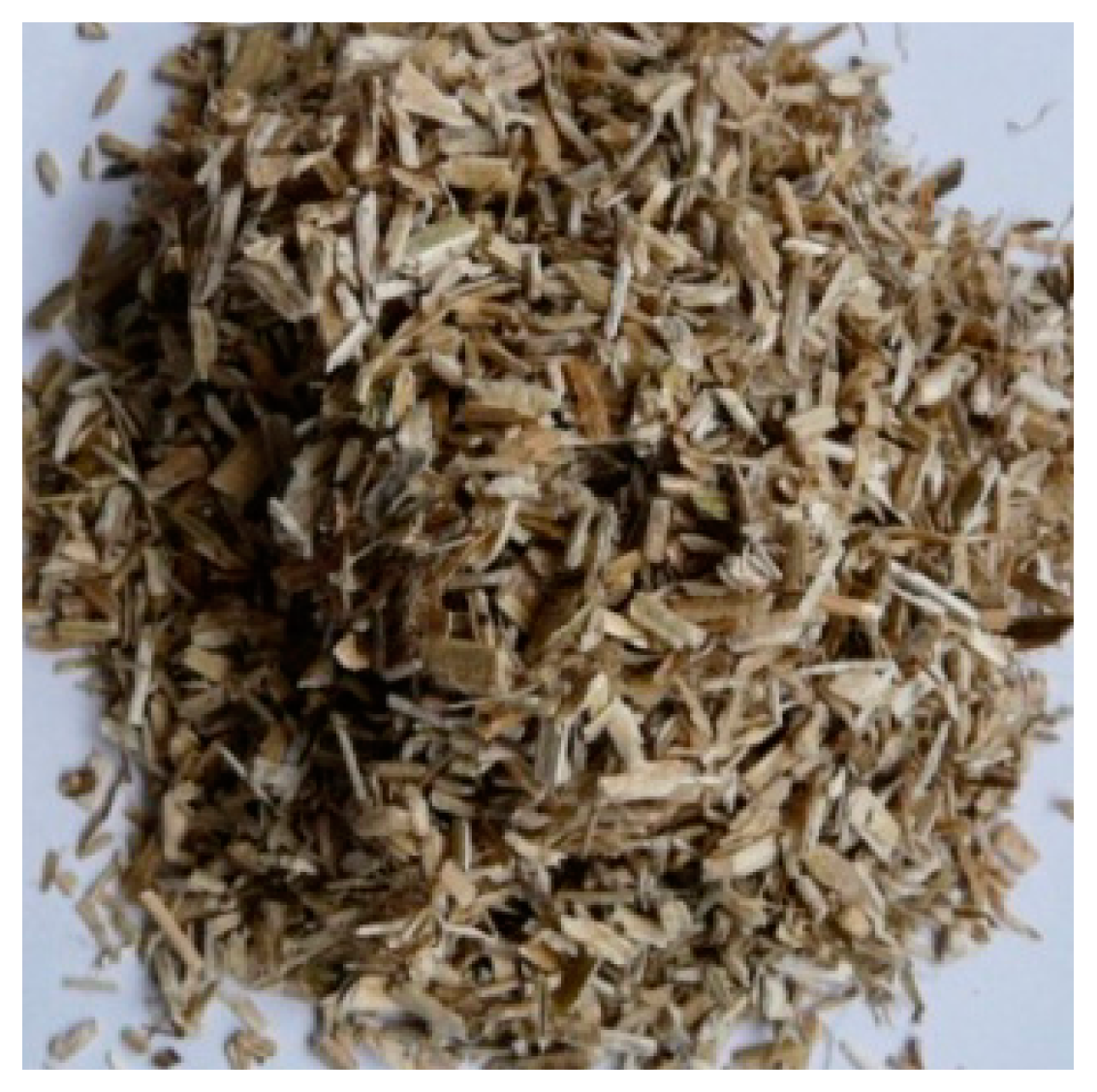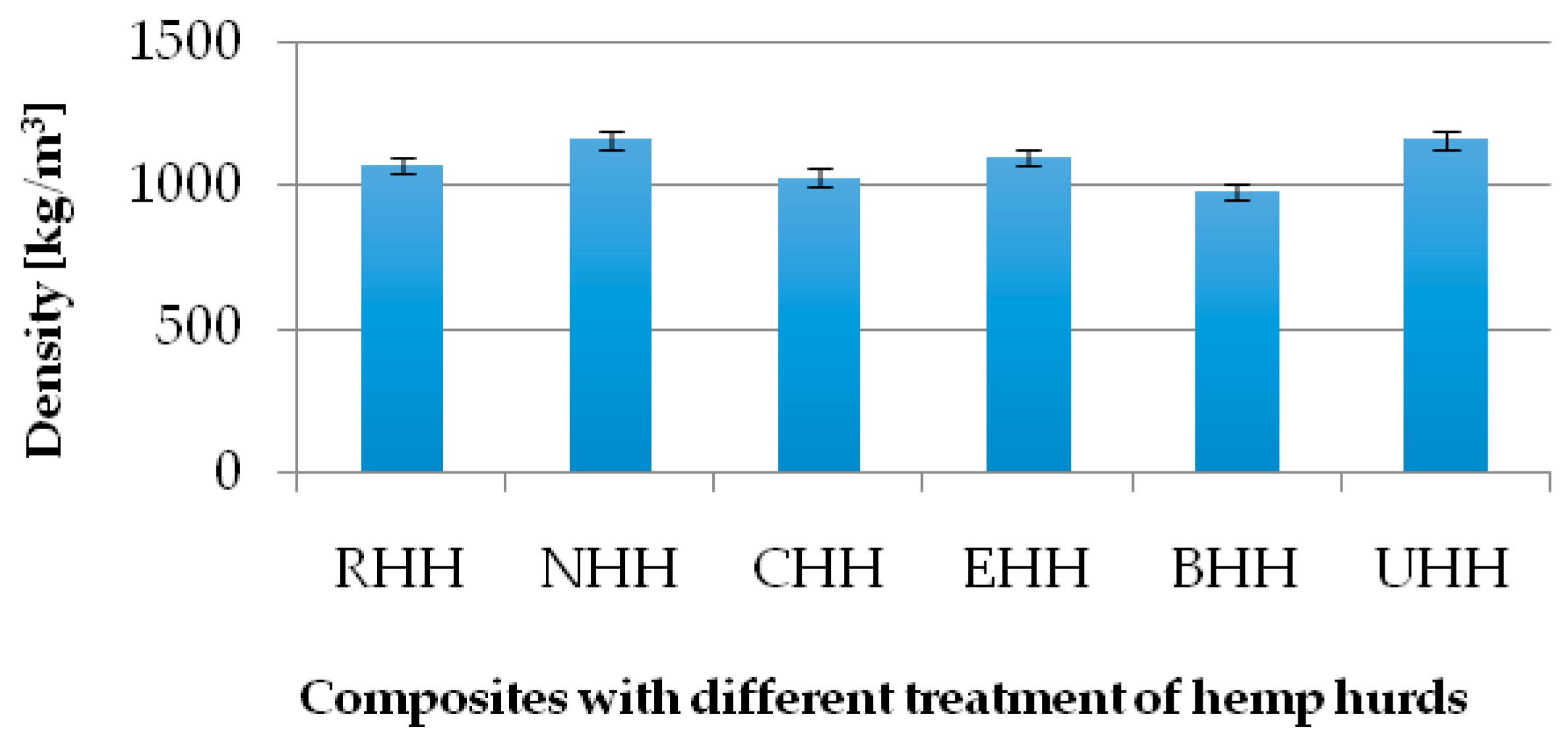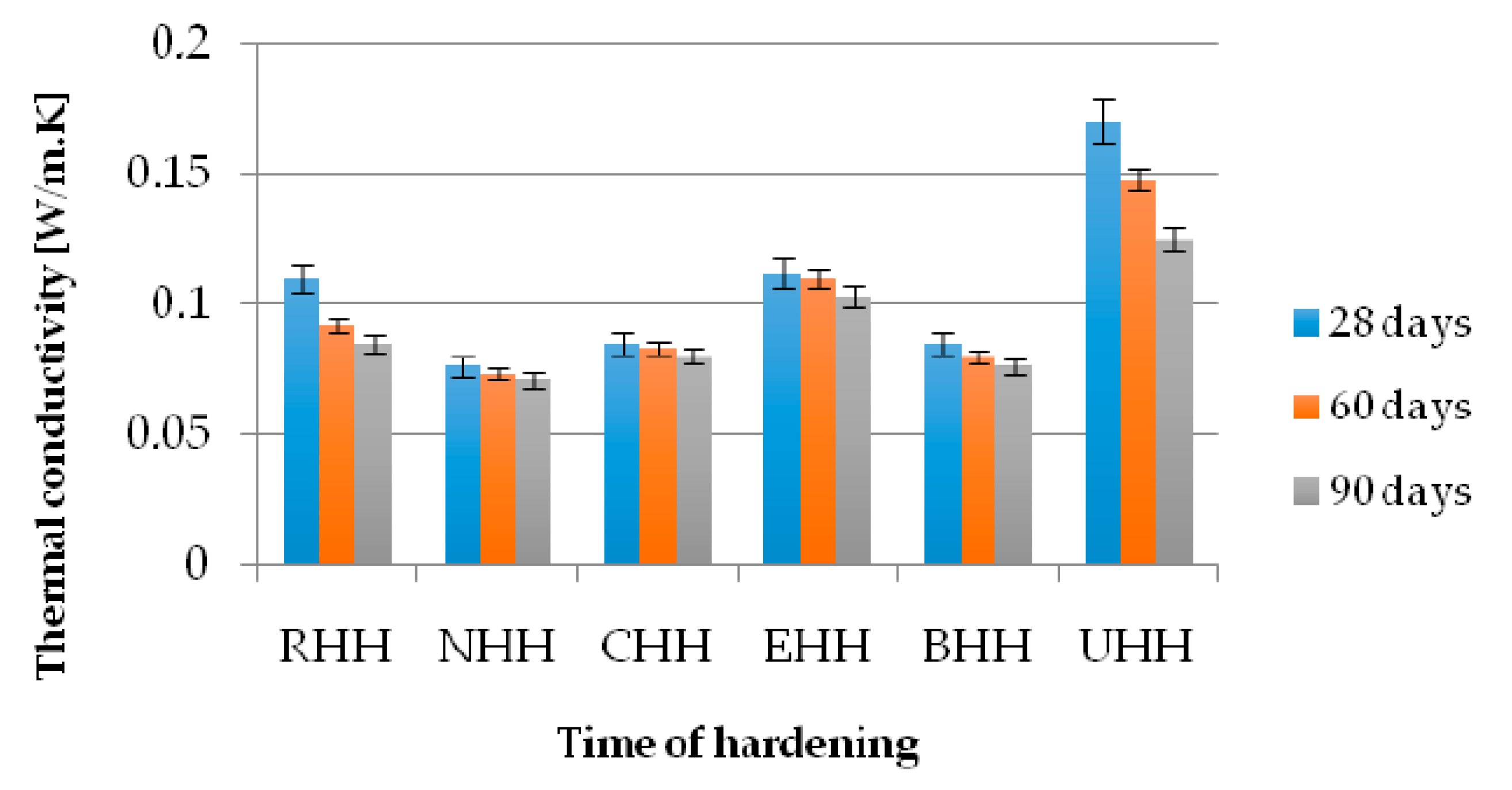Sustainable Bio-Aggregate-Based Composites Containing Hemp Hurds and Alternative Binder
Abstract
:1. Introduction
2. Materials and Methods
2.1. MgO-Cement
2.2. Hemp Hurds
2.3. Preparation of Composites
2.4. Determination of Composite Properties
3. Results and Discussion
4. Conclusions
Acknowledgments
Author Contributions
Conflicts of Interest
References and Notes
- Elfordy, S.; Lucas, F.; Tancret, F.; Scudeller, Y.; Goudet, L. Mechanical and thermal properties of lime and hemp concrete (“hempcrete”) manufactured by a projection process. Construct. Build. Mater. 2008, 22, 2116–2123. [Google Scholar] [CrossRef]
- Ku, H.; Wang, H.; Pattarachaiyakoop, N.; Trada, M. A review on the tensile properties of natural fibre reinforced polymer composites. Compos. B Eng. 2011, 42, 856–873. [Google Scholar] [CrossRef] [Green Version]
- Gavrilescu, D.; Tofanicä, B.M.; Puitel, A.C.; Pétrea, P. Sustainable use of vegetal fibres in composites. Sources of vegetal fibres. Environ. Eng. Manag. J. 2009, 8, 429–438. [Google Scholar]
- Réh, R. Admixtures of non-wooden lignocellulosic matarials in combination with wood particles in composite materials. PRO LIGNO 2013, 9, 519–524. [Google Scholar]
- Sassoni, E.; Manzi, S.; Motori, A.; Montecchi, M.; Canti, M. Novel sustainable hemp-based composites for application in the building industry: Physical, thermal and mechanical characterization. Energ. Build. 2014, 77, 219–226. [Google Scholar] [CrossRef]
- Bledzki, A.K.; Gassan, J. Composites reinforced with cellulose based fibres. Progress Polym. Sci. 1999, 24, 221–274. [Google Scholar] [CrossRef]
- Santos, S.F.; Tonoli, G.H.D.; Melja, J.E.B.; Florelli, J.; Savastano, H., Jr. Non-conventional cement-based composites reinforced with vegetable fibers: A review of strategies to improve durability. Mater. Constr. 2015, 65, 317. [Google Scholar] [CrossRef]
- Al-Kutii, W.; Nasir, M.; Johari, M.A.M.; Saiful Islam, A.B.M.; Manda, A.A.; Blaisi, N.I. An overview and experimental study on hybrid binders containing date palm ash, fly ash, OPC and activator composites. Constr. Build. Mater. 2018, 159, 567–577. [Google Scholar] [CrossRef]
- Da Silva Magalhaes, M.; Faleschini, F.; Pellegrino, C.; Brunelli, K. Cementing efficiency of electric arc furnace dust in mortars. Constr. Build. Mater. 2017, 157, 141–150. [Google Scholar] [CrossRef]
- Khan, K.; Amin, M.N. Influence of fineness of volcanic ash and its blends with quarry dust in mortars. Constr. Build. Mater. 2017, 154, 514–528. [Google Scholar] [CrossRef]
- Faleschini, F.; Zanini, M.A.; Brunelli, K.; Pellegrino, C. Valorization of co-combustion fly ash in concrete production. Mater. Des. 2015, 85, 687–694. [Google Scholar] [CrossRef]
- Siddique, R. Use of municipal solid waste ash in concrete. Res. Con. Rec. 2010, 55, 83–91. [Google Scholar] [CrossRef]
- Junakova, N.; Junak, J. Sustainable use of reservoir sediment through partial application in building material. Sustainability 2017, 9, 852. [Google Scholar] [CrossRef]
- Juenger, M.C.G.; Siddique, R. Recent advances in understanding the role of supplementary cenetitious materials in concrete. Cem. Concr. Res. 2015, 78, 71–80. [Google Scholar] [CrossRef]
- Fernández-Jiménez, A.; García-Lodeiro, I.; Donatello, S.; Maltseva, O.; Palomo, A. Specific examples of hybrid alkaline cement. MATEC Web Conf. 2014, 11. [Google Scholar] [CrossRef]
- Bocullo, V.; Vaičiukynienė, D.; Kantautas, A.; Borg, R.P.; Briguglio, C. Alkaline activation of hybrid cements binders based on industrial by-products. J. Sustain. Archit. Civ. Eng. 2017, 2, 65–73. [Google Scholar] [CrossRef]
- Ardanuy, M.; Claramunt, J.; Toledo Filho, R.D. Cellulosic fiber reinforced cement based composites: A review of recent research. Constr. Build. Mater. 2015, 79, 115–128. [Google Scholar] [CrossRef] [Green Version]
- Barra, B.; Bergo, P.; Alves, C., Jr.; Savastano, H., Jr.; Ghavami, K. Effects of methane cold plasma in sisal fibers. Key Eng. Mater. 2012, 517, 458–468. [Google Scholar] [CrossRef]
- Wei, J.; Ma, S.; Thomas, D.G. Correlation between hydration of cement and durability of natural fiber-reinforced cement composites. Corros. Sci. 2016, 1–15. [Google Scholar] [CrossRef]
- Toledo Filho, R.D.; de Andrade Silva, F.; Fairbairn, E.M.R.; de Almeida MeloFilho, J. Durability of compression molded sisal fiber reinforced mortar laminates. Constr. Build. Mater. 2009, 23, 2409–2420. [Google Scholar] [CrossRef]
- Savastano, H., Jr.; Fiorelli, J.; Dos Santos, S.F. Sustainable and Nonconventional Construction Materials Using Inorganic Bonded Fiber Composites; Woodhead Publishing: Sawston, UK, 2017; ISBN 9780081020029. [Google Scholar]
- Biagiotti, J.; Puglia, D.; Kenny, J.M. A review on natural fibre based composites—Part I: Structure, processing and properties of vegetable fibres. J. Nat. Fibers 2004, 1, 37–68. [Google Scholar] [CrossRef]
- Evrard, A. Sorption behaviour of Lime-Hemp Concrete and its relation to indoor comfort and energy demand. In Proceedings of the 23rd Conference on Passive and Low Energy Architecture (PLEA 2006), Geneva, Switzerland, 6–8 September 2006. [Google Scholar]
- Allin, S. Building with Hemp, 2nd ed.; Seed Press: Kenmare, Ireland, 2012; p. 146. ISBN 978-0-9551109-1-7. [Google Scholar]
- Walker, R.; Pavia, S.; Mitchell, R. Mechanical properties and durability of hemp lime concretes. Constr. Build. Mater. 2014, 61, 340–348. [Google Scholar] [CrossRef]
- Preikss, I.; Skujans, J.; Adamovics, A.; Iljins, U. Evaluation of hemp (Cannabis Sativa L.) quality parameters for building material from foam gypsum products. Chem. Eng. Trans. 2013, 32, 1639–1643. [Google Scholar] [CrossRef]
- Karade, S.R. Cement-bonded composites from lignocellulosic wastes. Constr. Build. Mater. 2010, 24, 1323–1330. [Google Scholar] [CrossRef]
- De Bruijn, P.B.; Jeppsson, K.H.; Sandin, K.; Nilsson, C.H. Mechanical properties of lime hemp concrete containing shives and fibres. Biosyst. Eng. 2009, 103, 474–479. [Google Scholar] [CrossRef]
- Amziane, S.; Arnaud, L. Bio-Aggregate-Based Building Materials: Applications to Hemp Concrete; ISTE Ltd.: London, UK; John Wiley & Sons, Inc.: Hoboken, NY, USA, 2013; ISBN 978-1-84821-404-0. [Google Scholar]
- Dalmay, P.; Smith, A.; Chotard, T.; Sahay-Turner, P.; Gloaguen, V.; Krausz, P. Properties of cellulosic fibre reinforced plaster: Influence of hemp or flax fibres on the properties of set gypsum. J. Mater. Sci. 2010, 45, 793–803. [Google Scholar] [CrossRef]
- Archila Santos, H.; Pesce, G.; Ansell, M.; Ball, R. Limeboo: Lime as a Replacement for Cement in Wall-Framing Systems with Bamboo-Guadua (Bahareque Encementado). In Proceedings of the 16th International Conference on Non-Conventional Materials and Technologies (NOCMAT 2015), Winnipeg, Canada, 10–13 August 2015. [Google Scholar]
- Hamšík, P.; Král, P. Composite materials from hemp and hydraulic lime for use in building and wood-constructions. Wood Res. 2014, 59, 871–882. [Google Scholar]
- Arizzi, A.; Brümmer, M.; Martin-Sanchéz, I.; Cultrone, G.; Viles, H. The influence of the type of lime on the hygric behavior and bio-receptivity of hemp lime composites used for rendering applications in sustainable new construction and repair works. PLoS ONE 2015, 10, e0125520. [Google Scholar] [CrossRef] [PubMed]
- Brzyski, P.; Barnat-Hunek, D.; Fic, S.; Szelag, M. Hydrophobization of lime composites with lignocellulosic raw materials from flax. J. Nat. Fibers 2017, 14, 609–620. [Google Scholar] [CrossRef]
- Barnat-Hunek, D.; Smarzewski, P.; Brzyski, P. Properties of hemp-flax composites for use in the building industry. J. Nat. Fibers 2017, 14, 410–425. [Google Scholar] [CrossRef]
- Balčiūnas, G.; Vėjelis, S.; Vaitkus, S.; Kairytė, A. Physical properties and structure of composite materials made by using hemp hurds and different binding materials. Procedia Eng. 2013, 57, 159–166. [Google Scholar] [CrossRef]
- Manzi, S.; Sassoni, E.; Motori, A.; Montecchi, M.; Canti, M. New composite with hemp hurds for sustainable buildings. Environ. Eng. Manag. J. 2013, 12, 31–34. [Google Scholar]
- Motori, A.; Manzi, S.; Montecchi, M.; Canti, M. A preliminary study of physical and mechanical properties of sustainable hemp fibers based composite materials for building insulated walls. In Proceedings of the 15th European Conference on Composite Materials (ECCM15), Venice, Italy, 24–28 June 2012. [Google Scholar]
- Fangueiro, R.; Rana, S. Advances in Natural Fibre Composites: Raw Materials, Processing and Analysis; Springer International Publishing: Cham, Switzerland, 2018. [Google Scholar]
- Balčiūnas, G.; Kizinievič, V.; Gargasas, J. Physical properties of building blocks from hemp shives aggregate and cementitious binder, manufactured in the expanded clay (vibro pressing) production line. Mater. Sci. Forum 2017, 908, 118–122. [Google Scholar] [CrossRef]
- Kidalova, L.; Stevulova, N.; Terpakova, E.; Sicakova, A. Utilization of alternative materials in lightweight composites. J. Clean. Prod. 2012, 34, 116–119. [Google Scholar] [CrossRef]
- Kumar, R.; Obrai, S.; Sharma, A. Chemical modifications of natural fiber for composite material. Der Chem. Sin. 2011, 2, 219–228. [Google Scholar]
- Thomsen, A.B.; Thygesen, A.; Bohn, V.; Nielsen, K.V.; Allesen, B.; Jorgensen, M.S. Effects of chemical and physical pre-treatment processes on hemp fibres for reinforcement of composites and for textiles. Ind. Crop. Prod. 2006, 24, 113–118. [Google Scholar] [CrossRef]
- Mwaikambo, L.; Ansell, M. Chemical modification of hemp, sisal, jute and kapok fibres by alkalization. J. Appl. Polym. Sci. 2002, 84, 2222–2234. [Google Scholar] [CrossRef]
- Stevulova, N.; Cigasova, J.; Estokova, A.; Terpakova, E.; Geffert, A.; Kacik, F.; Singovszka, E.; Holub, M. Properties characterization of chemically modified hemp hurds. Materials 2014, 7, 8131–8150. [Google Scholar] [CrossRef] [PubMed]
- Stevulova, N.; Cigasova, J.; Purcz, P.; Schwarzova, I.; Kacik, F.; Geffert, A. Water absorption behavior of hemp hurds composites. Materials 2015, 8, 2243–2257. [Google Scholar] [CrossRef]
- Kidalova, L. Determination of selected characteristics in hemp concrete. In Young Scientist: 3rd PhD. Student Conference of Civil Engineering and Architecture; Faculty of Civil Engineering, Technical university of Kosice: Kosice, Slovakia, 2011; pp. 1–6. ISBN 978-80-553-0639-1. [Google Scholar]
- Terpakova, E.; Kidalova, L.; Estokova, A.; Cigasova, J.; Stevulova, N. Chemical modification of hemp shives and their characterization. Procedia Eng. 2012, 42, 931–941. [Google Scholar] [CrossRef]
- Bydzovsky, J. Utilization of fast renewable raw materials in building products. In Proceedings of the 12th International Scientific Conference; Brno Technical University: Brno, Czech Republic, 2009; pp. 43–46. [Google Scholar]
- STN EN 12390-7: 2011 Testing Hardened Concrete. Part 7: Density of Hardened Concrete.
- STN EN 12087/A1: 2013 Thermal Insulating Products for Building Application. Determination of Long Term Water Absorption by Immersion.
- EN 12390-3: 2010 Testing Hardened Concrete. Part 3: Compressive Strength of Test Specimens.
- Cigasova, J.; Stevulova, N.; Junak, J. Influence of binder nature on properties of lightweight composites based on hemp hurds. Int. J. Mod. Manuf. Technol. 2013, 5, 27–31. [Google Scholar]
- Schwarzova, I.; Cigasova, J. Influence of binder nature on technical parameters of composites based on organic filler. In Young Scientist: 6th PhD. Student Conference of Civil Engineering and Architecture; Faculty of Civil Engineering, Technical University of Kosice: Kosice, Slovakia, 2014; pp. 1–8. ISBN 978-80-553-1668-0. [Google Scholar]
- Rousekova, I. Building Materials (In Slovak); Jaga Group: Bratislava, Slovakia, 2000. [Google Scholar]
- Stevulova, N.; Schwarzova, I. Changes in the properties of composites caused by chemical treatment of hemp hurds. Int. J. Chem. Biomol. Metall. Mater. Sci. Eng. 2014, 8, 363–367. [Google Scholar] [CrossRef]
- Stevulova, N.; Schwarzova, I.; Estokova, A.; Holub, M. MgO-based cement as an inorganic binder for hemp hurds composites. Chem. Technol. 2016, 67, 24–29. [Google Scholar] [CrossRef]
- Zhang, T.; Cheeseman, C.R.; Vandeperre, L.J. Development of low pH cement systems forming magnesium silicate hydrate (M-S-H). Cem. Concr. Res. 2011, 41, 439–442. [Google Scholar] [CrossRef]
- Diquélou, Y.; Gourlay, E.; Arnaud, L.; Kurek, B. Impact of hemp shiv on cement setting and hardening: Influence of the extracted components from the aggregate and study of the interfaces with the inorganic matrix. Cem. Concr. Compos. 2015, 55, 112–121. [Google Scholar] [CrossRef]
- MeloFilho, J.A.; Silva, F.A.; Toledo Filho, R.D. Degradation kinetics and aging mechanisms on sisal fiber cement composites systems. Cem. Concr. Compos. 2013, 40, 30–39. [Google Scholar] [CrossRef]
- Umurigirwa, B.S.; Vroman, I.; Mai, T.H.; Maalouf, C.H. Influence of chemical modification on hemp-starch concrete. Constr. Build. Mater. 2015, 81, 208–215. [Google Scholar] [CrossRef]
- Bouloc, P.; Allegret, S.; Arnaud, L. Le Chanvre Industriel: Production et Utilizations; Agricola: Paris, France, 2006; ISBN 2-85557-130-8. [Google Scholar]
- Murphy, F.; Pavia, S.; Walker, R. An assessment of some physical properties of hemp-lime concrete. In Proceedings of the BCRI Bridge Infrastructure Concrete Research Ireland; University College Cork: Cork, Ireland, 2010; pp. 431–438. [Google Scholar]
- Suslick, K.S. Sonochemistry. Science 1990, 247, 1439–1445. [Google Scholar] [CrossRef] [PubMed]
- Stevulova, N.; Estokova, A.; Cigasova, J.; Schwarzova, I.; Kacik, F.; Geffert, A. Thermal degradation of natural and treated hemp hurds under air and nitrogen atmosphere. J. Therm. Anal. Calorim. 2017, 128, 1649–1660. [Google Scholar] [CrossRef]
- Mohr, B.J.; Biernacki, J.J.; Kurtis, K.E. Microstructural and chemical effects of wet/dry cycling on pulp fiber-cement composites. Cem. Concr. Res. 2006, 36, 1240–1251. [Google Scholar] [CrossRef]






| Component | Content (hm.%) |
|---|---|
| MgO | 84.7 |
| CaO | 5.3 |
| Fe2O3 | 7.2 |
| SiO2 | 0.65 |
| LOI * | 0.85 |
| Hemp Hurds Sample | Designation |
|---|---|
| Reference (original) | RHH |
| NaOH treated | NHH |
| Ca(OH)2 treated | CHH |
| EDTA treated | EHH |
| Hot water boiled | BHH |
| Ultrasound treated | UHH |
© 2018 by the authors. Licensee MDPI, Basel, Switzerland. This article is an open access article distributed under the terms and conditions of the Creative Commons Attribution (CC BY) license (http://creativecommons.org/licenses/by/4.0/).
Share and Cite
Stevulova, N.; Cigasova, J.; Schwarzova, I.; Sicakova, A.; Junak, J. Sustainable Bio-Aggregate-Based Composites Containing Hemp Hurds and Alternative Binder. Buildings 2018, 8, 25. https://doi.org/10.3390/buildings8020025
Stevulova N, Cigasova J, Schwarzova I, Sicakova A, Junak J. Sustainable Bio-Aggregate-Based Composites Containing Hemp Hurds and Alternative Binder. Buildings. 2018; 8(2):25. https://doi.org/10.3390/buildings8020025
Chicago/Turabian StyleStevulova, Nadezda, Julia Cigasova, Ivana Schwarzova, Alena Sicakova, and Jozef Junak. 2018. "Sustainable Bio-Aggregate-Based Composites Containing Hemp Hurds and Alternative Binder" Buildings 8, no. 2: 25. https://doi.org/10.3390/buildings8020025





